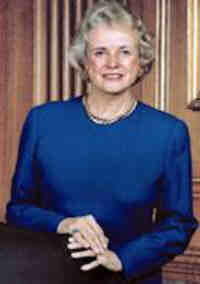 1981
First woman nominated to the US Supreme Court
^top^ 1981
First woman nominated to the US Supreme Court
^top^President Ronald Reagan nominates El Paso born Sandra Day O'Connor, 51, an Arizona court of appeals judge, to the US Supreme Court. Known as a moderate conservative, O'Connor is to replace retiring justice Stewart Potter, a Dwight D. Eisenhower appointee. O’Connor’s Senate confirmation hearings would begin later in the summer in the US Capitol. On September 21, the Senate unanimously approved her appointment, and on September 25, she was sworn in by Chief Justice Warren E. Berger as the first female Supreme Court justice in US history. After ruling conservatively during the 1980s, O'Connor emerged in the 1990s as the leading figure of a centrist bloc of justices. President Ronald Reagan nominates Sandra Day O'Connor, an Arizona court of appeals judge, to be the first woman Supreme Court justice in US history. On September 21, the Senate unanimously approved her appointment to the nation's highest court, and on September 25 she was sworn in by Chief Justice Warren Burger. Sandra Day was born in El Paso, Texas, in 1930. She grew up on her family's cattle ranch in southeastern Arizona and attended Stanford University, where she studied economics. A legal dispute over her family's ranch stirred her interest in law, and in 1950 she enrolled in Stanford Law School. She took just two years to receive her law degree and was ranked near the top of her class. Upon graduation, she married John Jay O'Connor III, a classmate. Because she was a woman, no law firm she applied to would hire her for a suitable position, so she turned to the public sector and found work as a deputy county attorney for San Mateo, California. In 1953, her husband was drafted into the US Army as a judge, and the O'Connors lived for three years in West Germany, with Sandra working as a civilian lawyer for the army. In 1957, they returned to the United States and settled down in Phoenix, Arizona, where they had three children in the six years that followed. During this time, O'Connor started a private law firm with a partner and became involved in numerous volunteer activities. In 1965, she became an assistant attorney general for Arizona and in 1969 was appointed to the Arizona State Senate to occupy a vacant seat. Subsequently elected and reelected to the seat, she became the first woman in the United States to hold the position of majority leader in a state senate. In 1974, she was elected a superior court judge in Maricopa County and in 1979 was appointed to the Arizona Court of Appeals by Governor Bruce Babbitt, a Democrat. Two years later, on July 7, 1981, President Reagan nominated her to the Supreme Court to fill the seat of retiring justice Stewart Potter, an Eisenhower appointee. In his 1980 presidential campaign, Reagan had promised to appoint a woman to the high court at one of his earliest opportunities, and he chose O'Connor out of a group of some two dozen male and female candidates to be his first appointee to the high court. O'Connor, known as a moderate conservative, faced opposition from anti-abortion groups who criticized her judicial defense of legalized abortion on several occasions. Liberals celebrated the appointment of a woman to the Supreme Court but were critical of some of her views. Nevertheless, at the end of her confirmation hearings on Capitol Hill, the Senate voted unanimously to endorse her nomination. On 25 September 1981, she was sworn in as the 102nd justice--and first woman justice--in Supreme Court history. Initially regarded as a member of the court's conservative faction, she later emerged from William Rehnquist's shadow (chief justice from 1986) as a moderate and pragmatic conservative. On social issues, she often votes with liberal justices, and in several cases she has upheld abortion rights. She is known for her dispassionate and carefully researched opinions on the bench and is regarded as a prominent justice because of her tendency to moderate the sharply divided Supreme Court. . |
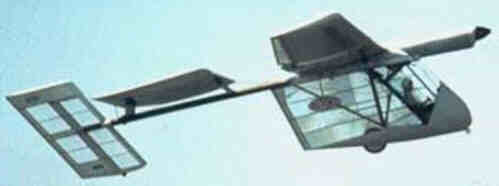 1981
Solar-powered plane crosses Channel and then some.
^top^ 1981
Solar-powered plane crosses Channel and then some.
^top^The world's first solar-powered aircraft, the Solar Challenger, designed by Paul MacCready, 55, flies from the Pointoise Cormeilles airport, near Paris, to the Manston Royal Air Force Base, in Kent, Eng., a distance of 258 km, in 5 hr 23 min at an average speed of about 48 km/h and a cruising altitude of 3350 m. The pilot is Stephen Ptacek, weighing 55 kg. The plane, powered by 16'128 solar cells connected to two electric motors, weighs 95 kg and has a wingspan of 14.3 m. A human-powered MacCready plane, the Gossamer Albatross, had made a 37 km crossing of the English Channel on June 12, 1979. |
| 1976 Female cadets enrolled
at West Point
^top^ For the first time in history, women are enrolled into the United States Military Academy at West Point, New York. On May 28, 1980, sixty-two of these female cadets would graduated and be commissioned as second lieutenants. The US Military Academy, the first military school in America, was originally founded as a school for the US Corps of Engineers on March 16, 1802. Located on the high west bank of the Hudson River, West Point was the site of a Revolutionary-era fort built to protect the Hudson River Valley from British attack. In 1780, Patriot General Benedict Arnold, the commander in charge of the fort, agreed to surrender West Point to the British in exchange for six thousand pounds. However, the plot was uncovered before it fell into British hands, and Arnold fled to British protection. In 1812, the growing threat of another war with Great Britain resulted in congressional action to expand the US Military Academy's facilities and increase the West Point corps. Beginning in 1817, the academy was reorganized by superintendent Sylvanus Thayer--later known as the "father of West Point"--and the school became one of the nation's finest sources of civil engineers. During the Mexican-American War, West Point graduates filled the leading ranks of the victorious US forces, and with the outbreak of the Civil War, former West Point classmates regrettably lined up against each other in the defense of their native states. In 1870, the first African-American cadet was admitted into the US Military Academy, and in 1976, the first female cadets. The academy is now under the general direction and supervision of the department of the US Army, and has an enrollment of about 4300 students. 24 years later, military women are still complaining about harassment (in all parts of the US Armed Forces). See above (year 2000) also http://www.militarywoman.org/harass5.htm |
| 1969 First US troops withdrawn
from South Vietnam A battalion of the US 9th Infantry Division leaves Saigon in the initial withdrawal of US troops. The 814 soldiers were the first of 25,000 troops that were withdrawn in the first stage of the US disengagement from the war. There would be 14 more increments in the withdrawal, but the last US troops did not leave until after the Paris Peace Accords were signed in January 1973. |
| 1964 New US ambassador arrives
in Saigon Gen. Maxwell Taylor, the new US ambassador to South Vietnam, arrives in Saigon. As a military man with considerable experience in Vietnam, he was viewed by the South Vietnamese government, the US military establishment, and the Johnson administration as the ideal individual to coordinate and invigorate the war effort. Presumably because of his arrival, a bomb was thrown at the US Embassy and two grenades exploded elsewhere in Saigon; no one was injured and only slight damage was caused. |
1958 US President Eisenhower signs Alaska statehood bill
| 1955 China announces it will
provide aid to Hanoi Officials in China and Hanoi announce that Beijing will extend 800 million yuan (about $200 million) in economic aid to Hanoi. This announcement followed a trip to Beijing by Ho Chi Minh and his ministers of finance, industry, agriculture, education and health. On July 18, the Soviet Union announced that it would grant Hanoi 400 million rubles (about $100 million) in economic aid. This aid from fellow communist nations helped sustain North Vietnam in its war against the South Vietnamese and their American allies until 1975, when they defeated the South Vietnamese forces and reunified the country. |
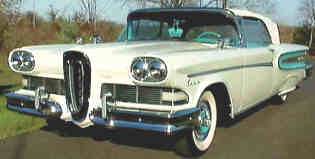 1954
Edsel team formed
^top^ 1954
Edsel team formed
^top^The Ford Motor Company forms a styling team to take on the project of designing an entirely new car that will later be named the Edsel. The decision comes as Ford enjoys its greatest historical success in the 1950s. The 1954 Thunderbird had outsold its Chevy counterpart, the Corvette, and the consumer demand for automobiles, in all price brackets, was steadily increasing. In exuberant Ford plants signs that had once read "Beat Chevrolet" were changed to a more ambitious tune: "Beat GM." [photo: 1958 Edsel Citation >] The Ford Motor Company consisted of four brand names: Ford, Mercury, Lincoln, and Continental, listed from lowest to highest in price range. Ford executives believed that there was a gap in the marketplace between the Mercury and the Lincoln, where a new car would compete against GM’s Oldsmobile and Buick lines. In the middle of the 1950s Americans seemed to have an insatiable hunger for high horse-powered, heavily styled cars, with lots of chrome and many accessories. So Ford planned to fill the public’s appetite with a suitable answer. The company spared no expense in the development of its new car, even going so far as to employ famous American poet Marianne Moore to supply possibilities for its name. After an extensive name search and no satisfactory result, somebody suggested that the car be named after Henry Ford II’s father, Edsel. Ford balked at the suggestion initially but later relented on the grounds that his father deserved a tribute, and he urged the car’s designers to live up to his father’s name. Edsel had always had a knack for design, even if his business sense hadn’t always lived up to his father’s expectations. The Edsel project was launched with great fanfare and vigorous advertising. During the years between the car’s conception and its production, the American economy took a downturn. By the time the Edsel was released in 1957, the high end of the car market had once again contracted. Public reaction to the car’s exaggerated styling was tepid at best, with particular objections aimed at the Edsel’s awkward looking "horse collar" grill. Sales for the car started slowly and foundered. Newly appointed company vice-president Robert McNamara was charged with the task of salvaging the operation. Had McNamara held the position years earlier, historians point out, the Edsel project may never have been taken on as McNamara strongly believed Ford should concentrate on the economy car market. McNamara attempted to improve the car’s construction and appearance, but when the attempt failed he was forced to halt production of the car at a disastrous loss of $250 million. To this day the Edsel remains the biggest failure in American car history, "a monumental disaster created for tomorrow’s markets created by yesterday’s statistical inputs." However, history has treated the Edsel more kindly, and its looks are now considered to be an attractive example of 1950s flair. |
| 1942 Nazis
to sterilize Jews at Auschwitz
^top^ Heinrich Himmler, in league with three others, including a physician, decides to begin experimenting on women in the Auschwitz concentration camps and to investigate extending this experimentation on males. Himmler, architect of Hitler's program to exterminate Europe's Jewish population, convenes a conference in Berlin to discuss the prospects for using concentration camp prisoners as objects of medical experiments. The other attendees are the head of the Concentration Camp Inspectorate, SS General Richard Glueks; hospital chief, SS Major-General Gebhardt; and one of Germany's leading gynecologists, Professor Karl Clauberg. The result of the conference is that a major program of medical experimentation on Jewish women at Auschwitz is agreed upon. These experiments were to be carried out in such a way as to ensure that the prisoners were not aware of what was being done to them. (The experimentation would take the form of sterilization via massive doses of radiation or uterine injections.) It was also decided to consult with an X-ray specialist about the prospects of using X rays to castrate men and demonstrating this on male Jewish prisoners. Adolf Hitler endorsed this plan on the condition that it remained top secret. That Heinrich Himmler would propose such a conference or endorse such a program should come as no surprise to anyone familiar with his resume. As head of the Waffen-Schutzstaffel ("Armed Black Shirts"), the SS, the military arm of the Nazi Party, and assistant chief of the Gestapo (Geheime Staatspolizei = “Secret State Police”) ), Himmler was able over time to consolidate his control over all police forces of the Reich. This power grab would prove highly effective in carrying out the Fuhrer's Final Solution. It was Himmler who organized the creation of death camps throughout Eastern Europe and the creation of a pool of slave laborers. |
| 1941 US forces occupy Iceland
^top^ During World War II, the neutral United States moved closer to war with Germany when US forces landed on Iceland to take over its garrisoning from the British. From thereon, the US Navy took over the responsibility of protecting convoys in the nearby sea routes from attack by German submarines. With Iceland now under US protection, the Royal Navy had a freer hand to concentrate their warships in a defense of their embattled Mediterranean positions. The US military operation came less than a month after, when President Franklin D. Roosevelt froze all German and Italian assets in the United States and expelled the countries' diplomats in response to the German torpedoing of the American destroyer Robin Moor. With the occupation of Iceland, much of the North Atlantic was now in the American sphere, and US warships patrolled the area and notified London of all enemy activity they encountered. |
1930 Construction begins on Boulder Dam, later renamed Hoover Dam.
| 1914 Tuesday : in the aftermath of the June
28 assassination in Sarajevo of Archduke Francis Ferdinand of
Austria-Hungary and of his wife, Sophia:
|
1905 53ºC, Parker Ariz (state record)
1904 Fermez les écoles religieuses! Toutes les congrégations religieuses, y compris celles qui jusque-là étaient autorisées, se voient interdire de dispenser un enseignement. La promulgation de cette loi entraînera la fermeture de 2400 écoles.
1898 US President McKinley signs resolution of annexation of Hawaiian Islands.
| 1896 Bryan
attacks the gold
standard
^top^ The Presidential campaign of 1896 was, in many ways, a battle over money. As was expected, the Republican campaign, led by the party's presidential nominee, Ohio governor William McKinley, centered on maintaining the gold standard. On the other side of the fence, the Democrats took a cue from the Populist party and latched on to the free coinage of silver as one of their guiding issues. While the Democrat's decision to support silver shocked a number of political observers, their nominee for the Oval Office proved to be even more surprising. The Democrats had already settled on their issue, but the summer of 1896 found them without a clear candidate for the Oval Office. That all changed at the party's national convention in Chicago on July 7 when William Jennings Bryan, then just a young scribe from Nebraska, stepped to speak before the Democrat's 20'000 delegates. An ardent supporter of the silver movement, Bryan seized the reins of the party by railing against the Republican's and their "demand for a gold standard." During his speech, Bryan laid down his now famous vow against gold and the Republicans: "You shall not press down upon the brow of labor this crown of thorns, you shall not crucify mankind upon a cross of gold." These indelible words sent the delegates into frenzy and effectively sealed Bryan's unlikely nomination as the Democrat's candidate for President. Alas, Bryan's fiery oratory proved to be no match for McKinley's fat coffers: backed by the money and influence of the nation's business leaders, the Republicans were able to lavish roughly $7 million on their campaign. Bryan, on the other hand, spent a scant $300'000 and ultimately lost his bid for the White House. |
1863 first military draft by US (exemptions cost $100)
| 1863 Kit
Carson's campaign against the Amerindians
^top^ Lt. Colonel Christopher "Kit" Carson leaves Santa Fe with his troops, beginning his campaign against the Indians of New Mexico and Arizona. A famed mountain man before the Civil War, Carson was responsible for waging a destructive war against the Navajo that resulted in their removal from the Four Corners area to southeastern New Mexico. Carson was perhaps the most famous trapper and guide in the West. He traveled with the expeditions of John C. Fremont in the 1840s, leading Fremont through the Great Basin. Fremont's flattering portrayal of Carson made the mountain man a hero when the reports were published and widely read in the east. Later, Carson guided Stephen Watts Kearney to New Mexico during the Mexican-American War. In the 1850s he became the Indian agent for New Mexico, a position he left in 1861 to accept a commission as lieutenant colonel in the 1st New Mexico Volunteers. Although Carson's unit saw action in the New Mexico battles of 1862, he was most famous for his campaign against the Indians. Despite his reputation for being sympathetic and accommodating to tribes such as the Mescaleros, Kiowas, and Navajo, Carson waged a brutal campaign against the Navajo in 1863. When bands of Navajo refused to accept confinement on reservations, Carson terrorized the Navajo lands--burning crops, destroying villages, and slaughtering livestock. Carson rounded up some 8000 Navajo and marched them across New Mexico for imprisonment on the Bosque Redondo, over 500 km from their homes, where they remained for the duration of the war. |
| 1853 Ouverture commerciale du
Japon L'amiral Perry commandant une escadre des États Unis débarque au Japon. Un traité de commerce sera signé. Il ouvrira le Japon aux américains et aux occidentaux. Jusqu'au milieu du XIX ème siècle, les étrangers n'avaient pu prendre pied au Japon, sauf rares exceptions. C'était à cette époque un petit pays dont le nom "Hih-Pen" signifie "l'Empire du Soleil Levant". |
| 1797 Impeachment
of Senator Blount
^top^ For the first time in US history, the House of Representatives exercised its constitutional power of impeachment, and voted to charge Senator William Blount of Tennessee, 48, with "a high misdemeanor, entirely inconsistent with his public duty and trust as a Senator." In 1790, President George Washington had appointed Blount, who had fought in the American Revolution, as governor of the "Territory South of the River Ohio," now known as Tennessee. Although he was a successful territorial governor, personal financial problems led him to enter into a conspiracy with British officers to enlist frontiersmen and Cherokee Indians to assist the British in conquering parts of Spanish Florida and Louisiana. Before the conspiracy was uncovered, Blount presided over the Tennessee Constitutional Convention, and in 1796 became the state's first US senator. However, in 1797, the plot was revealed, and on July 7, the House of Representatives votes to impeach Senator Blount. The next day, the Senate votes by a two-thirds majority to expel him from its ranks, and on December 17, 1798, exercises its "sole power to try all impeachments," as granted by the Constitution, and initiates a Senate trial against Blount. As vice president of the United States, Thomas Jefferson was president of the Senate and thus presided over the impeachment trial proceedings. After two months, Jefferson and the Senate decided to dismiss the charges against Blount, determining that the Senate had no jurisdiction over its own members beyond its constitutional right to expel members by a two-thirds majority vote. By the time of the dismissal, Blount had already been elected as a senator to the Tennessee state legislature, where he was appointed speaker and served as such until his death on March 21, 1800. The constitutional conundrum of conducting a trial of an impeached senator has not yet been resolved. |
1789 In Paris, a company of Swiss mercenary soldiers arrives at the Bastille to bolster its garrison of 82 soldiers, at the request of Bernard-Jordan de Launay, the military governor of the Bastille, who feared that his fortress would be a target for the revolutionaries. There were severe food shortages in France that year, and popular resentment against the rule of King Louis XVI was turning to fury. In June, the Third Estate, which represented commoners and the lower clergy, had declared itself the National Assembly and called for the drafting of a constitution. Initially seeming to yield, Louis legalized the National Assembly but then surrounded Paris with troops and dismissed Jacques Necker, a popular minister of state who had supported reforms. In response, mobs began rioting in Paris at the instigation of revolutionary leaders.
1768 Firm of Johann Buddenbrook founded, in Thomas Mann's 1900 novel
1668 Isaac Newton receives MA from Trinity College, Cambridge
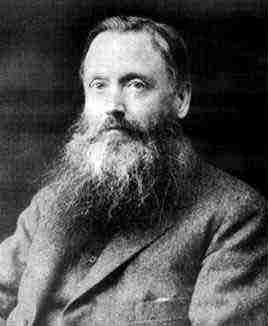 1942
1942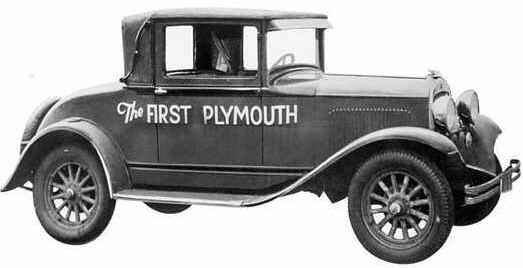 1928
1928